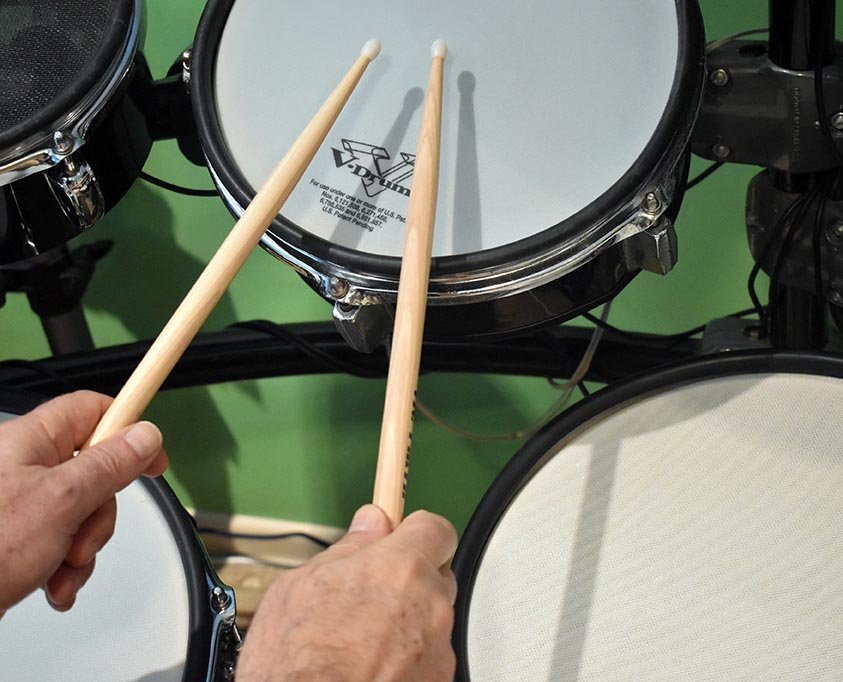I hung up my sticks after leaving school, in favour of study, career and family. But, once a drummer, always a drummer – and for many years, I hankered to get back behind the kit.
Electronic drums made it possible for me to return to drumming without disrupting the family and annoying the neighbours. It also made it easy for me practise, hone my skills and build the repertoire needed to get back into gigging with a band.
One of the biggest lingering doubts for ‘lapsed drummers’ is “can I still play?”. It’s not unusual for returning drummers to worry about forgetting everything they previously knew. But, as they say, it’s like riding a bicycle – except maybe you need a bit more help along the way.
Contributed to Roland Australia by Allan Leibowitz, Editor of digitalDrummer
Tips for Regaining Your Drumming Chops
1. Gear
Clearly, you need drums to play and that can be confusing as the market has changed substantially since you last owned a kit. Acoustic drums range from super-cheap no-name brands to uber-expensive custom kits – with plenty of choices in between. And then, of course, there are electronic kits, which have improved dramatically in quality, feel and sound and also become much more affordable.
2. Sticks
Unless you’re thinking of playing the cajon or bongos, you’ll need to find sticks that suit your grip and playing style. The 2Bs of your youth may not feel right for Pearl Jam or The Rolling Stones.
3. Lessons
Your local drum teacher can get you off to a great start by assessing your skills and offering tailored instruction and advice. And don’t be shy: they deal with adult students of all levels, so there’s no judgement or embarrassment. They can tell you what needs work and devise a practice routine that works for you.
4. Practice
Just a few minutes a day will quickly get you back up to speed, especially if you use some of the skill-building apps and tools built into modern electronic drum kits. There are tools which measure your timing and accuracy and which provide instant feedback on how you’re doing. Regardless of the type of kit, it’s a good idea to practise with a metronome – and even there, the technology has evolved from what we used ‘back in the day’.
5. Rudiments
Remember when tapping out ruffs on a snare seemed mindlessly boring? Well, it turns out those skills are the building blocks of good drumming. If you still remember your Flams, Six-stroke Rolls and Paradiddles, it’s much more fun doing them on a full kit and incorporating them into grooves and drum fills. Think of rudiments as phrases which form part of your drumming vocabulary rather than as a chore.
6. Resources
Learning has never been easier and it’s no longer limited to books. Google and YouTube have made it possible to find “How To Play” video instructions for almost any song or genre. There are terrific instruction videos which break down the difficult parts and let you learn as you watch. If you read music, you can download PDF notation – either for free or for pocket change.
7. Play along
Electronic kits generally contain lots of play along songs, allowing you to practise and build skills while playing to songs that you know and like. You can also connect your phone or tablet to your kit (even wirelessly with some modules) to play along to your current playlist. And you can also buy ‘drumless tracks’ or use a range of free or cheap apps to create your own minus-drums songs which are great to play to.
8. Play with others
There are few experiences which can rival the thrill of making music with others, so look out for a local band and strut your stuff. Even if you only end up playing in someone’s garage, it’s very rewarding to learn new songs, collaborate on arrangements and then nail them live. And if your aim is playing in public, there are programs like Weekend Warriors which bring together ‘mature aged’ musos for performance experiences. There are also Facebook groups dedicated to finding band members in your city or town. And even in time of lock-down, it’s possible to jam online, with ever-improving tools and programs.
9. Engage
Social media has made it easy to find people with similar interests and you’ll be able to hook up with drummers just like you in your own neighbourhood or on the other side of the world. You can share experiences and learn from others who have ‘been there and done that’.
10. Push yourself
A large part of drumming is muscle memory, and with a bit of practice, the stuff you knew before should come back quickly. But if you can add the musical sophistication that you have gained over the years, you can overcome some of the lost dexterity and energy of your youth to become an even better drummer than before. You no longer have to prove yourself, so you can now enjoy the process and play for the music.
Final Word
Even if you haven’t tapped your steering wheel or slapped your thighs for many years, drumming never leaves you. After a few fumbles, you should easily get back into the groove when you pick up sticks after a long break. And with so many new and innovative tools and resources freely available, there has never been a better time to revisit percussion.
It’s not too late to pick up where you left off – and even progress beyond that, so grab those sticks and start hitting out again!
Aditional Resources
Getting Back into Drums and Drumming
Learn to Play Drums
It’s Never Too Late To Learn The Drums
About the Author

Allan Leibowitz is currently the editor of digitalDrummer, the only global magazine for electronic percussion.








